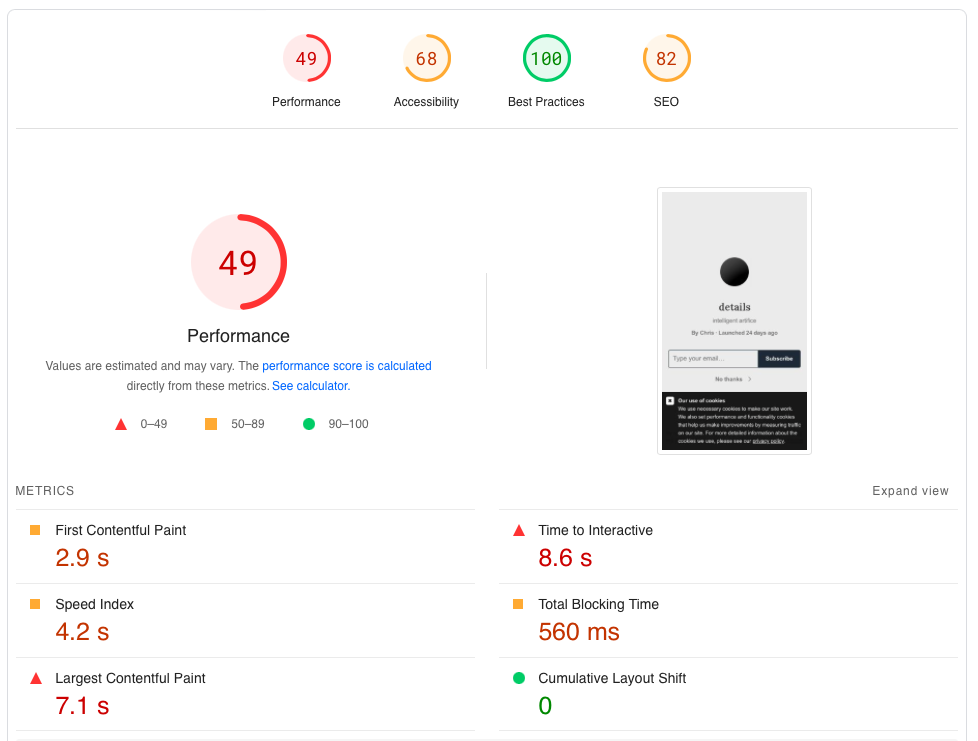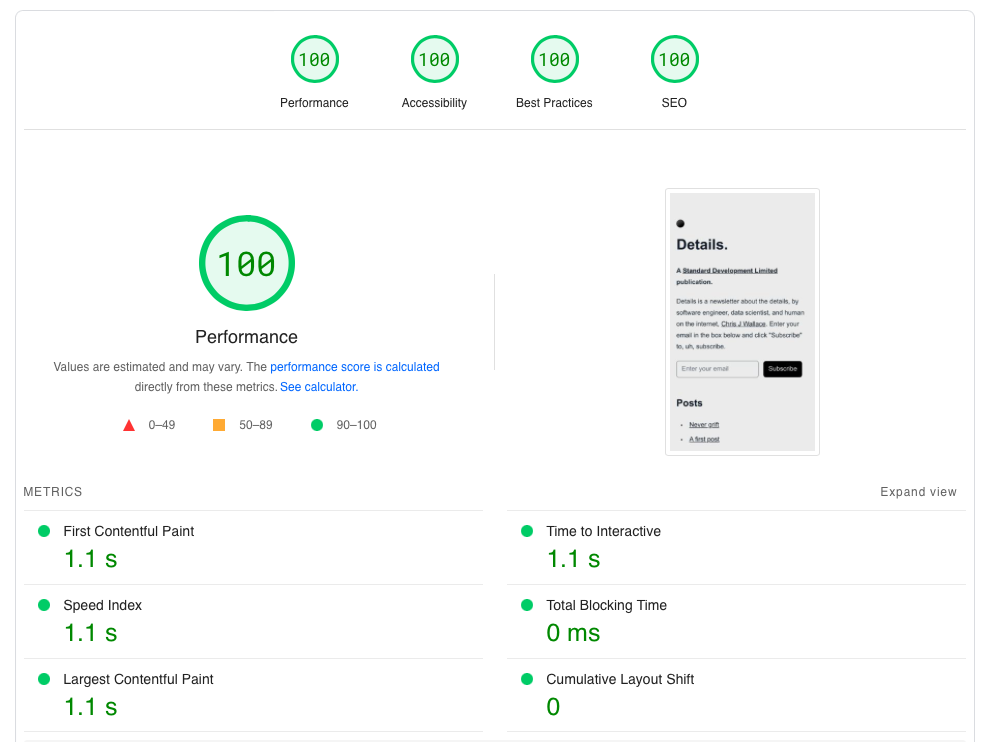The Ghost of a Substack
This was the hypothesis.
Desire 1. I want to write a lot, because it is a good way to develop ideas (writing is thinking!), and because, by publishing it, you attract other folks who are interested in the same things. It’s networking for introverts.
Desire 2. I am a technologist. As such, I’m inclined to tinkering. I want to customize things to my liking, because it’s fun to do, and because I can.
These two desires were in conflict. Upon weighing them, I decided I needed to stop tinkering, get out of my own way, and write a lot. So I thought I’d try Substack, a newsletter platform, chosen for ease. Minimal necessary config. Minimal possible config. I already read a couple of Substack newsletters. I’d give it a whirl, and I’d be able to Just Write. Like I said, this was the hypothesis.
A mere two newsletters in, it felt a bit… not me.
I started uploading a couple of old posts from my blog. One of them is called Your personal blog does not need analytics. It does not take a lot of introspection to realize the irony of posting that to a third party site which openly tracks visitors, requests linking your social media profile, and co. (Substack is not atypical in this regard, and I don’t think it’s doing anything particularly nefarious there, FWIW).
Substack is a VC funded company. By necessity, it has objectives that I don’t. Those annoying pop ups you get mid-way through reading an article that prompt you to subscribe? They’re because Substack benefits from having many subscribers that might be monetized in the future. That’s the business model. It’s a reasonable business model for writing! It aligns incentives between writers and the platform. But, well, even if my goal were a billion subscribers (it isn’t), I don’t want the platform deciding how I achieve that.
I disabled those pop-ups because they get in the way of a high-quality reading experience. (Read: they’re annoying as fuck. No human in history has ever received a pop-up mid-article and thought, “Oh gee, thanks for reminding me to subscribe. I’m glad I’m doing this instead of reading the sentence I was just reading.” This is not hard to get right. I’d say it’s hard to get wrong, but they managed.). The point is, I had to disable them: they’re on by default. And Substack is pushy about recommending other newsletters, and generally encouraging engagement with Substack itself. Cool, whatever, that’s your job as a company, but I Do Not Want.
A thing that surprised me was that linking to my Substack page felt sort of… inauthentic? Like I’d always be slightly promoting the platform itself, rather than my own thoughts, words, and deeds.
The eagle eyed among you may have noticed right away that this email is coming from a different address, and with different styling and whatnot. After a measly two Substack posts, I’ve moved to Ghost. I’m not here to promote Ghost, it just met my requirements:
- It’s not VC funded, and it is profitable, so it’s less likely to disappear.
- The technology is open source, so if it does disappear, I’m not high and dry.
- I pay for it, which is a good thing. By funding the service, I’m mitigating the need for Ghost to employ any shady marketing dark patterns to get more readers subscribed. You, dear reader, should never hear from Ghost directly.
- Finally, I’m using Ghost as a headless CMS, so all the content is published to my site, which I own, and on which I choose not to use marketing cookies or any other trappings of surveillance capitalism. (Transparency: I use Plausible, a privacy-preserving analytics script). I do not, and never will, sell information about site visits. I don’t want data about you. It’s just nice to know that a number of people are reading.
Again, I’m not staning for Ghost. I’m a new customer, and I don’t benefit from recommending that platform in particular. The point I am slowly making is that having control over your own platform is a good thing.
Believe it or not, this post also isn’t intended as a dunk on anyone using Substack. Having an easy way to publish online, even to make a living doing so, is a good thing. In particular I hope that long-form, investigative journalism, which is hard to do under an ad-funded news-site model, will flourish. Not everyone wants to build their own site to run a blog and newsletter.
But I do. It turns out I care a lot about control. I buy the idea that you should not build your castle in other people’s kingdoms.
By way of example, here’s a small thing. Here are the Lighthouse scores for the landing page for the Substack version of this newsletter, on mobile. (Maybe they’re called PageSpeed Insights scores instead of Lighthouse scores now? Or PageSpeed uses Lighthouse? The sun rises and sets, the seasons change, Google has a suite of barely distinguishable products cough meet, chat, hangouts, talk, voice cough. These things we know to be true).

The desktop stats are not as bad, so I’m cherry picking a little. Nonetheless, here are the stats for the equivalent page on my own site.

Lighthouse scores aren’t everything (obviously). But that’s pretty good, right? It definitely brings me, personally, joy to craft the experience I want people to have on my site.
High quality experiences come about when someone cares enough to notice all the stuff that is in the way of that, and has the agency to fix it. This is not the case in so much of work. Running your own little indie corner of the web is an excellent way to have that somewhere.
All of which to say, the new homepage for the newsletter is standard.dev/details (this has since changed).
Having set up a newsletter twice in the space of a few weeks, I’ve just about exhausted my excuses for not writing. Here’s how I expect it to go: I’m gonna publish basically whenever I want for a while, with an emphasis on writing a lot. Not every post will be a “newsletter”, and some will go straight to the blog, though I’ll probably link to them in a newsletter. Once I’ve published a whole bunch of junk, I might settle into weekly or something.
As a treat for having read all of this, here is some more recommended reading I’ve been pondering this week (“it’s a pie eating challenge, and the prize is more pie”):
- Programming as Theory Building (pdf link) is a 1985 paper by Peter Naur putting forth the case that the primary activity of the programmer is not producing code, but producing a theory of the problem being addressed. It’s only 14 pages, and I’m only halfway through that, but it is fantastic. It is that rare find which clearly articulates something you already knew but had not yourself crystallized. Highly recommended for anyone who programs, perhaps even more so for anyone who leads or manages people who program.
- Do Large Language Models learn world models or just surface statistics? I might write more on this. LLMs are conditional probability distributions over tokens. It’s amazing what we can do with that, but that’s what they are. Looking for knowledge, truth, and creativity in an LLM betrays a fundamental misapprehension about what they are. Nonetheless, the paper linked from the article is thought provoking. I slightly object to the term “world model”. They’re language models. They abstract, sure. But what they abstract — the world that they model, if you like — is language.
Chris
✌️